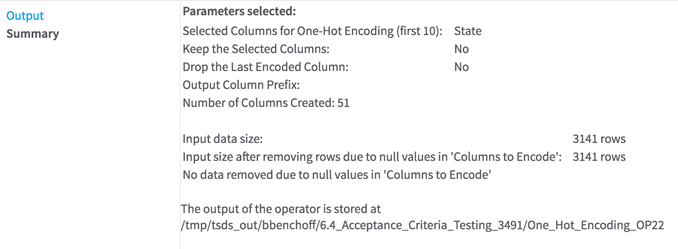One-Hot Encoding
Performs one-hot encoding on a set of categorical columns selected: it encodes categorical features using a one-hot scheme (also known as "one-of-K" scheme), and outputs a binary column for each distinct category in the input column.
Information at a Glance
| Category | Transform |
| Data source type | HD |
| Sends output to other operators | Yes1 |
| Data processing tool | Spark |
The One-Hot Encoding operator is useful for turning categorical predictors into numeric (binary) predictors for algorithms that do not support categorical variables natively.
Input
A single HDFS tabular data set.
- Bad or Missing Values
- Dirty data: When parsing delimited data, the One-Hot Encoding operator removes dirty data (such as strings in numeric columns, doubles in integer columns, or rows with the incorrect number of values) as it parses. These rows are silently removed because Spark is incapable of handling them.
Null values: Before performing one-hot encoding, the operator filters any rows that contain null values in the specified Columns to Encode. The operator then processes these rows with null values according to the value of the Write Rows Removed Due to Null Data To File parameter. The number of rows removed due to null data is reported in the Summary tab of the visual output.
Restrictions
For the maximum number of categories for each column selected on Columns to Encode, the default values is 30; this value can be modified in the Advanced Spark Settings menu (in the parameter Max Column Distinct Categories).
Configuration
| Parameter | Description |
|---|---|
| Notes | Any notes or helpful information about this operator's parameter settings. When you enter content in the Notes field, a yellow asterisk is displayed on the operator. |
| Columns to Encode
*required |
Select the categorical column(s) on which to perform one-hot encoding. |
| Keep Encoded Columns | Define whether the input columns to encode should be kept in the output - yes or no (the default). |
| Drop Last Category | Select
Yes (the default) to indicate that the last category in the column to encode should be dropped. Otherwise, select
No.
For example, if a column to encode "categ" contains three categories ("a", "b", "c") and Yes is selected for this parameter, the output data set contains only two encoded binary columns: "categ_a" and "categ_b" ("categ_c" is dropped). |
| Output Column Prefix | (Optional) Specify a string to prepend to all the output encoded column names. This option can be useful if you want to select all of the encoded columns in a subsequent operator, because they all start with the same prefix, which simplifies filtering on the first letters and then selecting them. |
| Write Rows Removed Due to Null Data to File | Rows with null values (only in the
Columns to Encode) are removed from the analysis. Use this parameter to specify that the data with null values is written to a file. The file is written to the same directory as the rest of the output. The filename is appended with the suffix
_baddata.
|
| Storage Format | Select the format in which to store the results. The storage format is determined by your type of operator.
Typical formats are Avro, CSV, TSV, or Parquet. |
| Compression | Select the type of compression for the output.
Available Avro compression options. |
| Output Directory | The location to store the output files. |
| Output Name | The name to contain the results. |
| Overwrite Output | Specifies whether to delete existing data at that path. |
| Advanced Spark Settings Automatic Optimization |
|
Additional Notes
- "Semi-terminal" operator
- A partial schema can be transmitted to subsequent operators at design time, but you must run the operator for subsequent operators to see the final output schema.
Note: The final output schema of the Correlation Filter operator is cleared if one of the following occurs.
In this case, the output schema transmitted to subsequent operators again becomes the partial schema defined at design time (hence, subsequent operators can turn invalid), and you must run the One-Hot Encoding operator again to transmit the new output schema.



